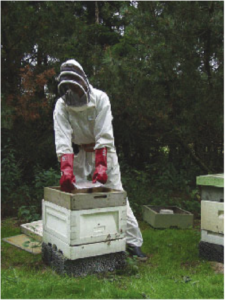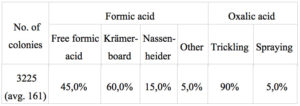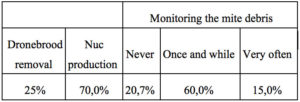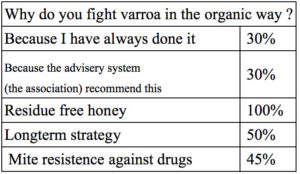Questionnaire 2005 (Methods and results)
As an ongoing development of the strategy for fighting varroa mites, the Danish Beekeepers Association is evaluating the organic way of fighting varroa every 2nd or 3th year. The „safe strategy” for the smaller beekeepers (less than 100 colonies) has been used for almost 20 years with success. From the large scale beekeepers point of view these methods may couse problems, due to the time consumption. Therefore we interviewed a number of larger beekeepers using the organic way of fighting varroa. We asked the beekeepers questions about fighting varroa. Since this is an ongoing study, we will just mention some of the interesting aspects of this survey.
Presented at the Apimondia congress in Dublin, Ireland 2005
Flemming Vejsnæs, Rolf Tulstrup Theuerkauf, Asger Søgaard Jørgensen
Danish Beekeepers Association, Fulbyvej 15, DK 4180 Sorø, Denmark
PH: + 45 57 86 54 70, dansk@biavl.dk

FORMIC ACID AND OXALIC ACID
The questionnaires points out that beekeepers on larger scale are going for methods that are rapid in use. None of these beekeepers are using the time-consuming methods such as lactic acid spraying, queen exclusion or heat treatment. Also drone brood removal is very restricted in use (25%). Some of the beekeepers answers that drone brood removal is used under certain conditions, such as single colonies with high number of mites within the season. The beekeepers were also asked about the use of volatile oils. Presumably none are using this method since this kind of product is not well known in Denmark. The main varroa treatment is the use of evaporation of formic acid right after the honey harvest in August – September and then a late treatment in October with oxalic acid trickling, combined with a spring treatment.
Formic acid is used by all beekeepers, but in different ways. The use of the krämer board is the most predominant method. Used by 60,0% of the beekeepers. The use of free formic acid is also common used. Several beekeepers remarks that the free formic acid is used only in nearby apiaries. The nassenheider evaporator is used by 15,0%.
Oxalic acid is used by all beekeepers except 2. Spraying of oxalic acid was used some years ago, but is not used anymore. Trickling is the dominant method. Evaporation of oxalic acid was only used by one beekeeper. This beekeeper used this method as the only treatment.
70,0% were producing nucs, to secure the number of colonies wintering out in the springtime. Several of the beekeepers pointed out that the production of nucs not are because of varroa, but solely to have a surplus of colonies in the springtime, in years with heavy winter losses.
Counting the mite downfall is not a big issue for the large scale beekeepers. 20,7% does never look for natural mite downfall. They can’t see the necessity. Their methods and strategy is satisfying. 60% are looking for mite downfall when it is necessary. But they never count mites. They look at the debris and make a very fast monitoring calculation „situation under control” or „situation might get out of control”. Spot test are used. Several are only looking on sealed drone brood, opening a few cells.
60,0% claims that they have never seen damaged colonies or bees. 25,0% claims that they do have single colonies now and then, that have damages due to varroa.
65,0% do realise that the organic varroa treatment is more time consuming than the use of drugs. Several of the beekeepers haven’t answered the question, since they never have used drugs, and therefore can’t compare. Some of the beekeepers even claim that there is no extra time consumption.
The reason for using the organic methods is very clear. All (100%) are doing this to ensure honey as a clean natural product without any kind of residues. 50% are doing this due to a long-term strategy and 45% are doing it because concerns regarding resistance to drugs.
75% of the asked beekeepers have never considered the use of any kind of drug as a possibility, not now or in the future. This was underlined very clearly by the beekeepers in the questionnaire. 10,0 % didn’t know if they might change strategy.



THE CHALLENGE OF ORGANIC BEEKEEPING IN THE FUTURE
The challenge for the organic varroa-treatment is to find cheap, fast and easy to handle varroa-treatment metods for the large scale beekeepers. Large scale beekeepers doesn’t use time on even good methods, if they are time consuming. The Danish large scale beekeepers have simplified the varroa strategy – using only formic acid (krämerboard) and oxalic acid trickling (spring and autum treatment). These methods are regarded as sufficient on the long term. Therefore nearly no time is used on monitoring mites.
The beekeepers realise that they are using more time on these methods, but have realised that this is the way to keep honey clean and as a natural product on the long term. This questionnaire will continue the winter 2005.
Download as poster: varroa-undersogelse2005